From April 2007 until June 2013, I thankfully got the opportunity of working as a scientific assistant at the Department of Electrical Engineering and Information Technology of Technical University of Munich (TUM) in the workgroup Technische Akustik of Prof. Dr.-Ing. Hugo Fastl (Lehrstuhl für Mensch-Maschine-Kommunikation, MMK). Besides the daily business and responsibilities in research and teaching, my main task consisted in setting up a laboratory for research on the human auditory perception in real and virtual listening conditions, and in conducting such experiments.
Fortunately, Deutsche Forschungsgemeinschaft (DFG) accepted our grant proposal for this project and generously supported our studies and thereby my successful doctorate (Doktor-Ingenieur) over a period of five years total.
The technologies primarily used for auralization in the project are headphone-based dynamic binaural synthesis and loudspeaker-based wave-field synthesis. Some of this work's results are documented by my publications. A comprehensive summary of the major results regarding binaural synthesis and headphone playback is given in my doctoral thesis "Interrelations of Virtual Acoustics and Hearing Research by the Example of Binaural Synthesis" (published by Verlag Dr. Hut, PDF).
This page is meant to provide a short historical overview on "my" lab's history and progress. The following pictures show parts of the lab, ...
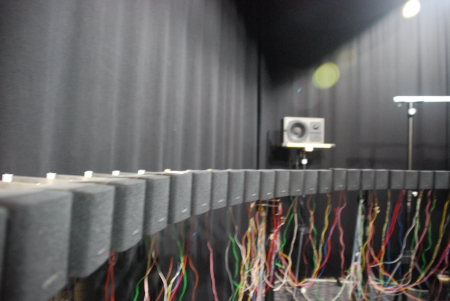

... where - despite the north-east-corner-basement location and the permanently darkened windows - my students and I lost a lot of sweat. Obviously the 6kW amplifier power and a couple of PCs contribute significantly to the climatic conditions in the lab.
Initial situation
The initial situation when I started work at the institute presented itself as follows: a former work shop in the basement of TUM's central campus was available for my project. However, the room had to be remodeled and equipped for the intended purpose.
The picture below illustrates the lab's state before the rearrangements took place. Since then (early 2007), many hundred hours of listening experiments have been conducted there.

The room was never meant to be used as an acoustics laboratory. Especially the acoustic insulation between the room and the neighboring three workshops is missing, and one long side is oriented towards Arcisstraße, the street. The walls between lab and institute workshop as well as between lab and corridor are built from plaster board and share the concrete floor, the two other walls are made from brick. Prior to the remodeling, the laboratory consisted of one room with a big door towards the corridor and three windows in light wells towards the street.
Planning and renovation
After coordinating the requirements of all potential lab users, funding for the renovation had to be acquired. With the generous help of the institute's "organization manager" in organizing funding and renovation, the beginning could be arranged around September 15, 2007.
After finishing the work on February 28th, 2008, a control and an experimental room were available, ...

... connected by a door and a window. In the experimental room, heavy curtains were mounted at all walls. With the help of a colleague, I attached additional curtains to the ceiling and constructed and mounted further room acoustical elements behind the curtains. The latter were intended to provide rather flexible room acoustical conditions within the experimental room.
With the end of March 2008, the laboratory was ready for the listening experiment hardware to be set up. Momentarily, me ...
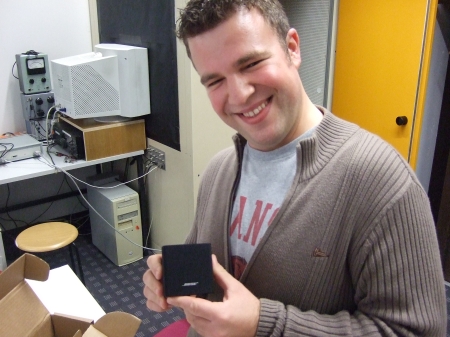
... and an extremely sedulous and handy student...

... started installing the experimental setup in the laboratory. The setup consisted of a 96 loudspeaker array with variable loudspeaker positions including eight(!) kilometers of loudspeaker cable, 48 two-channel amplifiers mounted in three racks, six 16-channel ADAT-converters, a 96-channel audio-interface, a head-tracking system, a 12-channel audio-interface, a 5.1-system of studio monitor loudspeakers attached to another 12-channel audio-interface, and several computers connected by an elaborate network:
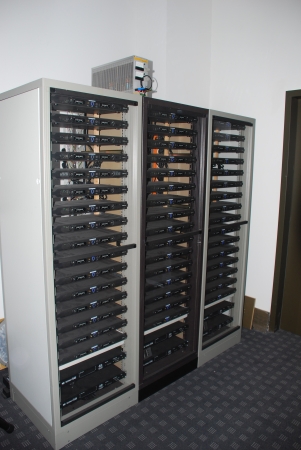
Being in a hurry, we frequently worked late, ...

... so that the basic hardware setup could be completed around August 1, 2008:
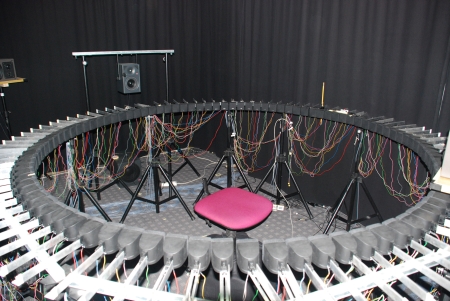
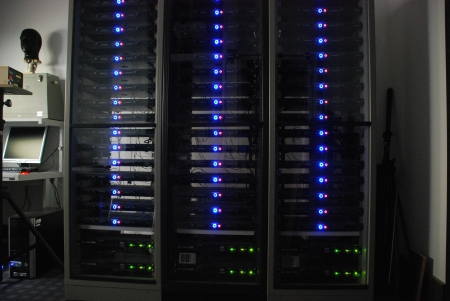
It turned out quickly that the audio interfaces initially selected were, while specified differently, not able to drive 96 channels synchronously. This fact required, after extensive problem identification, to change the interfaces including the controlling computer.
The audio-hardware was ready to use November 3rd, 2008, so that the lab setup had taken about 20 months, overall.
In the lab, the students I supervised and I myself conducted many hundred hours of listening experiments and countless electroacoustic measurements. The topics studied cover basic Psychoacoustics and experiments with electroacoustic systems as well as investigations on human auditory perception and audiovisual interactions in complex real and virtual environments.